Dandelion root tea is the all around wellness tea. Rich in antioxidant, flavonoids, vitamins, and minerals, it is traditionally used for blood sugar control, to support immunity, to detoxify the body and to support and protect the liver and kidneys. Dandelion root tea has been shown to reduce cancer tumors and resolve leukemia in scientific studies in Canada. And you have this miracle herb, dandelion root, growing near you, just waiting to be harvested and used in your daily tonic dandelion root tea.
Dandelion root tea
Did you plant dandelions in your herb garden this year? Neither did I. But I still have them growing on the pathways, and in the wild areas – anywhere the chickweed didn’t take over first. In the spring I harvest the young dandelion greens and unopened flowers to make dandelion tea, to add to green salads, and to stir into steamed spinach greens for just a hint of bitterness. Bitters are good for digestion, I learned in my Intermediate Herbal Course at the Herbal Academy of New England. (I love that course! Thanks for asking. I’ve learned more than I ever thought I would. More about that in another post.) Dandelions, all bitters really, support the liver and the gall bladder and encourage proper digestive action. Dandelion roots also stimulate detoxification and support both the liver and the kidneys to optimize their work. It’s a powerhouse of health that you might be overlooking.

Health benefits of dandelion
Every part of the dandelion is beneficial. Dandelion is a good source of Vitamins A, B, C, E, and vitamin K. The leaves also contain calcium, potassium, iron, magnesium, manganese, and zinc. While the root is a good source of potassium, calcium, and inulin, a prebiotic that supports our microbiome. Dandelion is also a good source of antioxidants, quercetin, coumarins, luteolin, taraxocoside, and phenolic acids.
The leaves are beneficial as a natural diuretic and since it is a rich source of potassium, it doesn’t deplete the body of potassium stores. Its diuretic properties help with kidney problems, increasing urine output, and flushing the body which can help with high blood pressure and urinary tract infections.
Dandelion leaves are also helpful for pancreatitis, easing the pain and supporting the pancreas as it heals.
Dandelion root protects the liver from the damage of toxins such as alcohol and medications, and can support liver health as it regenerates provided the toxin is removed. A 2010 Korean animal study demonstrated that dandelion root tea had liver-protective benefits against alcohol induced liver toxicity by increasing the antioxidant benefits and decreasing lipid peroxidation.
Dandelion is used in traditional folk medicine for its beneficial effects on type 2 diabetes. It reduces blood sugar levels, supports weight loss, reduces cholesterol, and helps in obesity. It is used in Russia, China, India, Turkey, and Mexico for the treatment of diabetes. Research is currently being done on extracting some of the dandelion constituents for patented drugs in this area.
The beneficial effects of dandelion on the liver support the body in removing histamine and easing allergies. This can be helpful in hay fever, hives, eczema, and psoriasis.
Dandelion has antimicrobial effects for biofilm bacterial infection and Staphylococcus aureus bacteria infection due to its phenolic constituents.
Safety of dandelion root extract
Dandelion has been used for thousands of years and is generally recognized as safe. However, those who are allergic to members of the asteraceae family, such as ragweed, chamomile, chrysanthemums, daisies, and marigolds, should use caution when using dandelion. Dandelion extracts can interact with some medications including lithium, antibiotics in the family of fluoroquinolones (for example: ciprofloxacin [Cipro] or levofloxacin [Levaquin]), glucose-lowering drugs, potassium-sparing diuretics, or medications related to blood clotting. If you are taking pharmaceuticals speak to your pharmacist or doctor before ingesting dandelion root tea.
The best time to harvest dandelion root tea
While you harvest the young greens and unopened flowers in spring, the roots should be harvested in the fall, after frost, before the winter’s rest. There is some discussion on whether early spring roots or late fall dandelion roots are best medicinally. There is a difference. Dandelion roots harvested in fall are slightly sweeter and less bitter than dandelion roots harvested in the spring. Both are helpful to your liver and bile production though. The fall dandelion roots have a higher concentration of prebiotic inulin, which encourages the good microbes in your gut to bloom. Having more beneficial microbes in your gut like lactobacillus improves your immune function, helps you think more clearly, protects you from bad microbes like staph, and strep, and even helps you maintain a healthy weight.
I like to harvest dandelion root tea in the fall because it’s easier to pull the root out when the soil is light after the vegetable harvest is finished. After the winter snow and the early spring thaw, the roots are more committed to their place in the soil and tend to break off, when I pull. So know that you can harvest dandelion roots in either fall or in the early spring before the heavy rosette of leaves form, but fall is best.
While you could conceivably harvest them in the middle of summer, if you wanted to, the dandelion roots would not be as medicinally potent, because the dandelion is putting its energy into growing leaves, flowers, and seeds. That energy is drawn from the root. Once the fluffy dandelion clocks (the seeds) are blown away by the wind, the dandelion draws in the sun’s energy through the leaves (photosynthesis) and replenishes the energy in the root, settling in for a long winter of dormancy. So if you have the patience, wait until after the first few touches of frost before you head out to the garden with your garden fork.
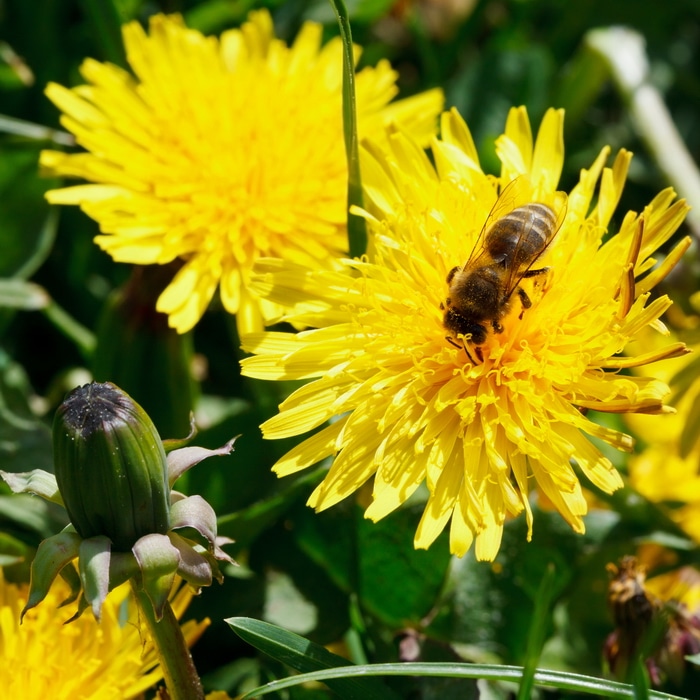
How to harvest dandelion roots
If you can wait until a few days after the rain, the soil will be more cooperative to your pulling the whole dandelion root up in one piece. If a piece of the root breaks off, the dandelion will come back in the spring – so there’s no problem if you lose a bit of the dandelion root.
You can use a digging fork and push it into the soil two or three inches away from the crown of the dandelion and then pull back on the fork, using the fork as a lever to lift the dandelion, root and all from the soil. Alternatively, if you have a spike or a heavy stick, you can poke it into the ground right beside the root, at the crown of the dandelion, and wiggle it a bit to loosen the soil. Then pull up on the dandelion leaves with your hands. The dandelion will come out of the soil with the root intact.
How to prepare the dandelion roots for tea
Take your dandelion roots, while still in the garden and shake off as much garden soil as possible. Use your pruning shears or a sharp knife and cut the long, green dandelion leaves from the base of the root. These can be washed and dried till crisp, and crumbled into salads and soups during the winter to add their bitterness and their nutrition. The leaves can also be tinctured with other bitters as a digestive aid. Or you can feed them to your chickens and goats. They love them, too. You can find more dandelion recipes here.
Rinse the dandelion roots under cool water. Use a soft brush to clean the dirt off the roots. They will become quite white with a nobby nature. They have the texture of a parsnip.
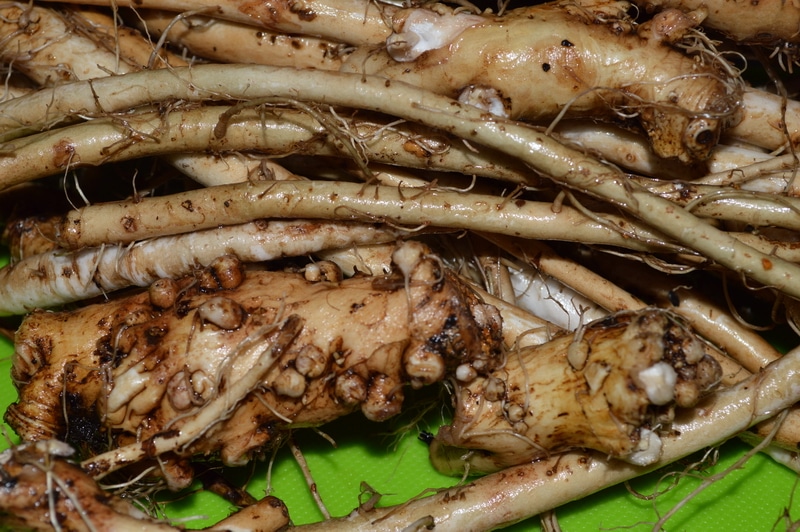
Slice the dandelion roots into 1/4 inch slices. Take the larger coined slices and quarter them so that all the slices are uniformly the same size. Dry the dandelion roots with some heat, from a dehydrator or in an oven, until hard and crisp. They can be cooled once they are very hard. Store in a glass jar, and label. The properly dried roots will keep for a year or more if you keep them in a cool, dry place.
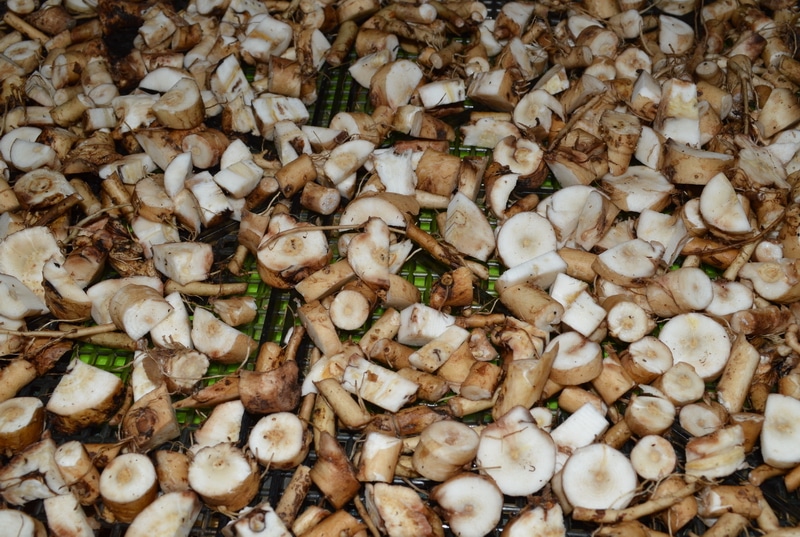
How to make dandelion root tea
Dandelion root tea is a nourishing diuretic tea, that supports the liver, and helps your body detoxify. It’s been used for centuries by traditional medicine makers for liver and kidney health. Dandelion root tea may even cure cancer. That premise is being studied at the University of Windsor. See my references below for more information about these exciting, evidence-based investigations. To make dandelion root tea, break the dandelion root in a mortar until it is chunky, and the size of lentils. Dandelion root tea is a decoction rather than an infusion. Simmer the root in a pan on the stove in water for about 15 minutes. Allow the decoction to settle, and then strain it into your cup. Those enamelled cast iron teapots can hold the decoction and strain it in one effort. They come with a mesh strainer that’s perfect for fine teas and herbal remedies. I use mine to make all my tea — both herbal and camellia — both infusions and decoctions.
If your cast iron teapot has an enamel lining, however, don’t use it on the stovetop. These kinds of teapots should only be used to steep tea, not to simmer the decoction on the stovetop. You can tell if you have an unlined or a lined cast iron teapot because the enamel lined teapots have a smooth, shiny surface. The cast iron teapots have a matte finish that usually doesn’t reflect much light. It’s safe to use the non-enamelled tetsubin on the stovetop to simmer the decoction over low heat.
Directions for dandelion root tea/decoction
Add 2 cups of water, to 1 tablespoon of herb. Simmer for 15 minutes. Shut off the heat. Allow the mixture to settle in the pan. Stain and pour into a cup. If you make extra, store the remainder in the fridge and consume it within 24 hours.
Studies at the University of Windsor show dandelion root tea effective against several drug resistant cancers, including melanoma and leukemia. Clinical trials are in phase 1 at the University of Winsor with patients showing remission with just 3 cups of dandelion tea per day. (See the references below for more information).
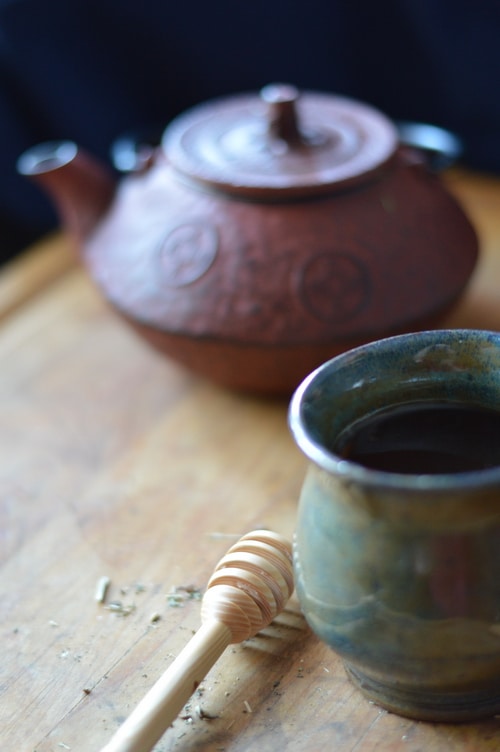
Doesn’t it make sense though, since dandelion root tea supports your liver and kidneys? These are the two organs responsible for dealing with waste and toxins in your body. And the best part of this “discovery” is that dandelion root tea did not harm any normal cells – food doesn’t usually cause harm to normal cells. Dandelion root tea is a food, a food that’s available free where you live. In fact, dandelions are pervasive and seem to follow human habitation. Have you noticed that the herbs we need most can be found close to where we are living? God planned it that way, I think.
When we first moved to our 140-acre mountain paradise, in zone 3, there were no dandelions. Seriously, I looked and I couldn’t find a single one. I never planted them. But here we are 12 years later and both garden and pasture are heavily blessed with dandelions. I’m not complaining. I love plants that don’t need to be babied to survive.
So get out to the garden and harvest some dandelion root tea from your own garden and drink the benefits.

But I don’t have a garden
What if you don’t have your own garden? Don’t harvest medicinal roots near roadways or anywhere that’s been sprayed with herbicides or pesticides. Most city parks, roadways, and public buildings will be suspect unless your city has put in place a no-spray by-law. If you can’t find some dandelion root tea growing near you, you can order it online from Mountain Rose Herbs, my favourite source of organic teas.
Learn more about using herbs for health and wellness from my Book
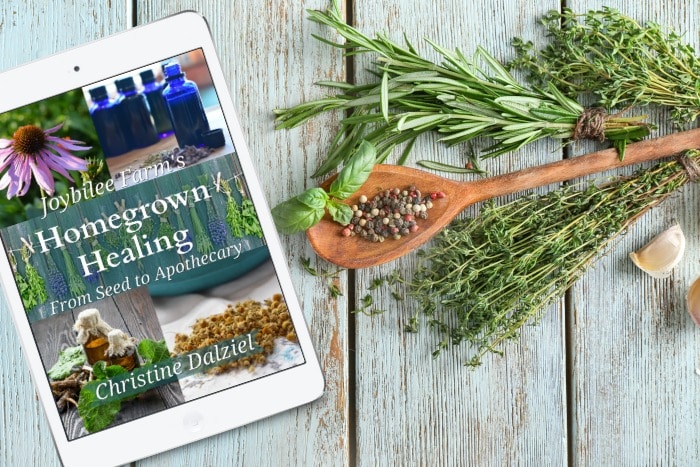
Homegrown Healing From Seed to Apothecary
My book Homegrown Healing From Seed to Apothecary will help you grow healing herbs in your own garden. Focusing on the easiest plants for beginners to grow, Homegrown Healing From Seed to Apothecary covers 30 plants, recommended by professional herbalists, that can be grown in the temperate zone. Initial garden preparation, garden design and harvesting tips lead the novice herbalist into early success. Choose which herbs to grow, learn how to use these herbs for your family’s health and wellness using the guidance in my book. You can find out more about this useful guide to growing more herbs and using them strategically here.
References:
“Evaluating The Efficacy Of Dandelion Root Extract as an Anticancer agent In Highly Aggressive and Resistant Cancers” paper given by Pamela Ovadje at The 9th Annual Conference of the Natural Health Products Research Society of Canada, May 22nd to 25th, 2012, Kelowna, BC, Canada.
“The Efficacy of Dandelion Root Extract in Inducing Apoptosis in Drug-Resistant Human Melanoma Cells” Evidence-Based Complementary and Alternative Medicine Volume 2011 (2011), Article ID 129045, 11 pages. J. Chatterjee,1 P. Ovadje,1 M. Mousa,1 C. Hamm,2 and S. Pandey





Colorado, Oregon, Washington. Bitter Almond seeds/Amygdalin
Are the roasted dandelion roots as nutritious or less nutritious than dried w low heat?